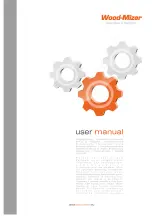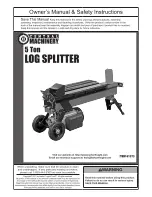
CAUTION:
DO NOT START OR RUN THE ENGINE BEFORE ADDING OIL IN THE HYDRAULIC RESERVOIR AND OIL IN
THE ENGINE.
OPERATING INSTRUCTIONS
WARNING: Read and thoroughly understand all instructions and safety information before operating
this log splitter. Failure to do so may cause serious injury or death. Do not allow anyone to operate
this log splitter who has not read this manual. As with all power equipment, a log splitter can be
dangerous if assembled or used improperly. Do not operate this log splitter if you have doubts or
questions concerning safe operation. Call our customer service department at 1-800-525-8322 to
address these concerns.
Si no entiende ingles, se prefiere que busque alguien que interprete las instrucciones para usted.
STEP 1: The hydraulic reservoir must be filled with oil. AW46 hydraulic oil is recommended when oil is needed. Automatic transmisssion fluid can
be substituted and should be used instead of hydraulic oil when temperatures are below 32 degrees F. Use only clean oil and take care to
prevent dirt from entering the hydraulic reservoir. Fill the hydraulic tank with approximately 3.5 to 4 gallons of hydraulic oil.
CAUTION:
WHEN TIGHTENING THE BREATHER CAP ON THE TANK, POINT THE HOLE AWAY FROM THE ENGINE
AND THE OPERATOR ZONE.
ENGINE OIL RECOMMENDATIONS
Use 4-stroke automotive detergent oil. SAE 10W-30 is recommended for general use. Refer to the SAE Viscosity Grades chart on page 17 of your
engine owner’s manual for average temperature ranges. The engine manufacturer recommends using API SERVICE Category SE or SF oil.
The engine oil capacity is 0.63 US qt (0.6 L). Always check oil level before starting the engine. Keep oil level at full.
STEP 2:
Page 12
STARTING INSTRUCTIONS
NOTE: REFER TO THE ENGINE OWNER’S MANUAL FOR COMPLETE INFORMATION ON STARTING, MAINTENANCE AND TROUBLE-
SHOOTING.
1) Move the fuel valve lever to the ON position.
2) To start a cold engine, move the choke lever to the CLOSE position.
To restart a warm engine, leave the choke lever in the OPEN position.
3) Move the throttle lever away from the SLOW position, about 1/3 of the way toward the FAST position.
4) Turn the engine switch to the ON position.
5) Pull the starter grip until you feel resistance, then pull briskly. Return the starter grip gently.
6) If the choke lever has been moved to the CLOSE position to start the engine, gradually move it to the OPEN position as the engine
warms up.
7) To stop the engine in an emergency, simply turn the engine switch to the OFF position. Under normal conditions, move the throttle lever
to the SLOW position and then turn the engine switch to the OFF position. Then turn the fuel valve lever to the OFF position.
For further information on starting and stopping the engine, refer to your engine owner’s manual.
After the hydraulic reservoir and the engine crankcase are filled with oil, start the engine. The hydraulic pump should prime itself. With the
engine running, move the hydraulic valve lever toward the foot plate. This will cause the cylinder to extend and expel air. When the cylinder
is fully extended, retract it. Repeat this procedure several times. An erratic movement of the cylinder indicates that there is still air in the
system. Add about 1.0 to 1.5 gallons more. Five gallons will register just above the top fill line on the dip stick.The total capacity of the entire
hydraulic system is 6.5 gallons. NOTE: If the tank is overfilled it will tend to expel oil from the breather cap when the cylinder is retracted.
Cycle the cylinder again until it has a constant speed indicating that all air has been expelled.
























